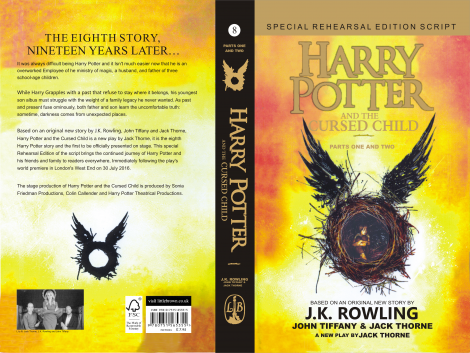Unveiling the Enigma: A Comprehensive Exploration of “Harry Potter and the Cursed Child” by J.K. Rowling

Introduction:
J.K. Rowling, the renowned architect of the Wizarding World, returned to the literary stage with “Harry Potter and the Cursed Child.” Co-authored with John Tiffany and Jack Thorne, this script of the West End play immerses readers back into the magical universe that captivated hearts worldwide. As a continuation of the beloved Harry Potter series, the script introduces a new generation of characters while revisiting the familiar faces that shaped readers’ childhoods.
Theatrical Origins and Literary Presentation:
Before delving into the narrative intricacies, it’s essential to acknowledge the unique format of “Harry Potter and the Cursed Child.” Initially conceived as a stage play, the script’s literary adaptation retains its theatrical origins. Presented in the form of dialogue and stage directions, the narrative unfolds with the brisk pace characteristic of a theatrical production. The transition from traditional prose to script format, while initially jarring for some readers, offers a distinctive and immersive storytelling experience.
Temporal Shifts and the Next Generation:
The narrative thrusts readers nineteen years into the future, with the epilogue of “Harry Potter and the Deathly Hallows” as its chronological starting point. The focus shifts to the offspring of the original characters, primarily Albus Severus Potter and Scorpius Malfoy. This temporal leap provides a fresh perspective on the Wizarding World, exploring the complexities of legacy, identity, and the enduring echoes of the past. Rowling, Tiffany, and Thorne masterfully navigate the delicate balance between nostalgia and innovation, seamlessly interweaving the familiar with the novel.
Character Development and Familial Dynamics:
Albus Severus Potter, burdened by the weight of his father’s legacy, emerges as a central figure grappling with self-discovery and the expectations thrust upon him. The exploration of Harry and Albus’s strained relationship offers a poignant examination of parenthood and the generational divide. The dynamics between characters, both new and familiar, resonate with authenticity, delving into the nuances of friendship, family, and the enduring bonds forged at Hogwarts.
Temporal Ripples and Alternative Realities:
The introduction of a Time-Turner as a central plot device opens the narrative to temporal intricacies and alternate realities. The repercussions of meddling with time form a compelling backdrop, offering a glimpse into the butterfly effect within the Wizarding World. The exploration of “what if” scenarios and diverging timelines adds a layer of complexity to the narrative, challenging characters and readers alike to confront the consequences of their choices.
Villainous Resurgence and Themes of Redemption:
As with any installment in the Harry Potter saga, the resurgence of dark forces and the specter of Voldemort loom large. The script navigates the delicate task of reintroducing a formidable antagonist while introducing elements of redemption and moral ambiguity. The nuanced portrayal of characters such as Draco Malfoy adds depth to the narrative, questioning the boundaries between good and evil and the capacity for change.
Critique and Controversy:
While “Harry Potter and the Cursed Child” garnered widespread acclaim for its inventive narrative and nostalgic resonance, it was not without its share of criticism. Some readers expressed reservations about the script format, citing a preference for Rowling’s traditional prose. Additionally, the narrative choices, particularly regarding certain character trajectories, sparked debates within the fandom. The reception of the script remains a testament to the passionate and discerning nature of the Harry Potter community.
Legacy and the Everlasting Magic:
“Harry Potter and the Cursed Child” contributes to the enduring legacy of the Wizarding World, ensuring that the magic transcends generations. The script invites readers to rekindle their love for the series while introducing new dimensions to the narrative tapestry. The exploration of friendship, sacrifice, and the inexorable passage of time resonates with readers who grew up alongside Harry, Ron, and Hermione.
Conclusion:
In revisiting the Wizarding World through “Harry Potter and the Cursed Child,” J.K. Rowling, John Tiffany, and Jack Thorne invite readers on a spellbinding journey that merges the familiar with the unforeseen. The script’s unique format challenges conventions, breathing life into the characters and landscapes that have become synonymous with magic. As Albus Severus Potter and Scorpius Malfoy navigate the complexities of their legacy, the narrative unfolds with a resonance that transcends the boundaries of genre and format. “Harry Potter and the Cursed Child” stands as a testament to the enduring enchantment of Rowling’s creation, ensuring that the magic of Hogwarts continues to captivate hearts across the globe.




